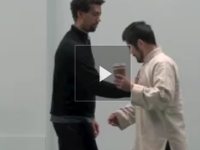Recently, I understand more about the statement:
“Rotation is the result of linear movements.”
Our actions are like on the tangent of a circle. The non-moving dot is the centre of the circle. Every linear action is very small. The direction changes all the time. The sequence of such actions along with non-moving dot cause the rotation. The actions are continued on top of each other, and they have a relationship with the non-moving dot. In the form, it is like dragging the flesh around some non-moving rod or dot. It is almost like someone pushes the arm on one side for elbow in, and someone else pushes the other side of the arm for hand out. This is related to the stretch that Master Chen Zhonghua showed on the inside or outside of the forearm. Another example is that if someone touches me in the front, I don’t move the front, but I stretch the back over or around that non-moving front.
According to Master Chen, all of the above are actions of oneself, and yin yang separation of oneself. It describes the relationship of self-actions. Actions in relation to the opponent is done by regulating the distance between the self-action and opponent. It is achieved by the stepping of the feet, without ever changing the self-action. This is a more detailed explanation of Grandmaster Hong Junsheng’s rotation vs revolution.
I realize that if I am able to 合 (he) (as if tied by a rope) with the opponent, my actions will have an effect on him. The better I become, the farther I can be away from the opponent without losing the 合. As a beginner, we start by getting close to the opponent, otherwise, it is too difficult to have any effect on the opponent. Master Chen always reminds us that we need to get in, get in, get in. Master Chen’s analogy on this is about how a rotating circular saw blade cannot cut wood until wood is pressed onto the saw blade, or the saw blade is pushed onto the wood. Master Chen says that all of these are effort to resolve the riddle, “If it is too loose (lack of engagement), power is lost; If it is too tight (jammed together), power cannot come out.”
Master Chen indicates that my understanding comes from knowing the theory, personal practice, and teaching. It is especially important that I am teaching people who are not combative, and I am allowed to push with thinking in it. The teaching has indeed allowed me to think about how the actions are supposed to fit into the principle. If I don’t do it quite well, I will just try again on the same person indicating that the last one is not good and why it is not good.
Related article:
http://practicalmethod.com/2014/01/rotation-is-the-result-of-linear-movements/



